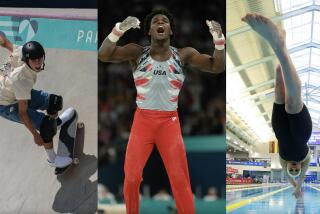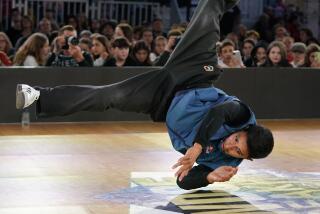You May Have to Put Your Weekend Warrior on Ice
- Share via
In spring, a young man’s fancy may turn lightly to thoughts of love, but a middle-aged guy’s fancy is likely to turn to baseball. Which means that a fancy won’t be the only thing turning. So will an ankle. Or a knee. Or a . . .
Take my husband, Steve, whose softball team’s season began a few weeks ago. Does the fact that he’s out there for fun, playing with a ragtag bunch of guys in their 40s and 50s, stop him from diving after a screaming line drive? Of course not. Because in his mind, Steve is still that lithe young athlete who used to make that play routinely, which is why he came home from his first game hunched over like an upside down L, his lower back in severe spasm.
Of course, the sport doesn’t have to be baseball; it could be basketball or soccer, volleyball or tennis. In fact, it doesn’t have to be a sport at all; it could be your regular workout. The participant could be male or female--anyone whose memories of past glories on the field of combat override common sense and drive him to believe that he’s capable of doing what he really hasn’t been able to do in more than 20 years. This, in a nutshell, defines most weekend warriors: Their spirit is still willing and competitive, but because their flesh hasn’t been adequately prepared for the chore ahead, it’s weak.
Weekend warriors end up hurt or hurting because they don’t warm up properly before participating. They seem to believe that a quick knee bend or two will release the magic. But even professional athletes--young men and women who play hard every day--vigorously stretch their limbs and ligaments prior to competing. Get to a Dodger game early, for instance, and you’ll see players in the outfield stretching and stretching and stretching.
What you may miss, unless you get to the stadium even earlier, is that before stretching the players have already brought up the core temperature of their bodies through light aerobic activities--usually jogging. Only after they start to feel themselves sweat a little do they begin their stretching routines. That way, their blood is moving faster and their joints and tendons are lubricated. They may even have preceded their aerobics with a hot bath or shower.
So if such a routine is important at 25, for someone who plays at the highest level, imagine how much more critical it is for a 45- or 55- or 65-year-old who sits in a chair all week. Just as no one would think to go straight from never running at all to competing in a full marathon, moving from sedentary to active requires preparatory steps.
Still, warming up properly won’t necessarily keep you from getting hurt if you don’t also stay within your boundaries or capabilities. Take me, for example. Not long ago I was at UCLA, working out informally at the track with two top track athletes. These guys were doing their normal routine, building toward an event, and I was keeping up fine. Then their workout kicked into hyper-speed, and I, overcome by the old competitive fire, tried to match them. The result? Next day, I could barely walk. The fact that I’d warmed up well and am in pretty good shape couldn’t protect me, because I’d overstepped what my baby boom body was capable of doing. It was stupid.
The antidote? Ice.
No freezer of a weekend athlete, or anyone who works out for that matter, should be without a large supply of ice for therapeutic purposes. Ice reduces swelling, which results from the buildup of fluids in a tissue or joint due to trauma of some kind. Initially, the cold decreases circulation, which is why you should leave the ice on the affected area in 15-minute segments--15 minutes on, then 45 off. Any longer than 15 minutes on per hour, the body will respond to the resultant numbness by trying to heat up that area, producing the opposite effect from the one you want.
I find that packages of frozen vegetables make excellent cold compresses, because they conform to the body’s shape. And I also keep several foam cups full of solid ice in the freezer. Rubbing one on the targeted area, I peel back the foam as the ice melts in order to reveal more ice. Around our house, with two dynamic kids and two active adults, the ice gets a real workout--as it did that Sunday afternoon when Steve came home from playing softball.
After he got situated with a frozen compress between the chair and his lower back, we spoke about the necessity of staying within our athletic boundaries. He listened as I lectured and agreed that he should, but there was a smile on his face. I asked what he was smiling about. “I made the play,” he said.
And I went to freeze more water.
Copyright 1998 by Kathy Smith
*
Kathy Smith’s fitness column appears weekly in Health. Reader questions are welcome and can be sent to Kathy Smith, Health, Los Angeles Times, Times Mirror Square, Los Angeles, CA 90053. If your question is selected, you will receive a free copy of her book “Getting Better All the Time.” Please include your name, address and a daytime phone number with your question.


